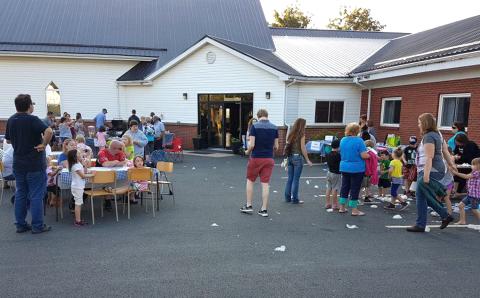July 2021: Officially time to look for a new church. I was struggling with loneliness and longing for community, and in-person requirements were easing up in Colorado enough to allow me to walk into a church again. But getting to this point was not easy, as my journal clearly reflects from that time:
I DREAD entering the church/space alone.
I DREAD the awkwardness, small talk, feeling like an outsider.
I miss (my old church) and the comfort and belonging, even though I know it didn’t start that way 16 years ago either.
I know we are not designed to practice our faith alone and I know I want to be a part of something … but inertia is a huge challenge! JUST DO IT, RIGHT?
I laugh at my attempts to motivate myself, but with my anxiety over the process and the ever-present reality that I’m 43 and single, there was no changing the awkwardness of looking for a new church.
The other huge issue was that we were still in the middle of a pandemic. Many churches were still online, and their safety protocols weren’t always clear on their websites. I had last attended an in-person indoor church service on Ash Wednesday of 2020 and went to only a few outdoor services in the summer and fall. I moved to Denver in December 2020, so church attendance meant watching live services on YouTube—if the feed didn’t cut out. Now it was July, a notoriously bad time to look for a new church because of vacations, guest pastors, and a rhythm that is far from normal. But it was time.
I did my Google search and website scour, listing churches that seemed to fit what I was looking for. Next I created a schedule of worship times and where I would attend each week. Then I took a deep breath one Sunday morning, pumped myself up, and made myself step into church after church hoping to find a new “church home.”
I hate the idea that we evaluate and shop for churches. I hate that I was judging churches based on summer services. I hate that churches are struggling to get people in the door, making this a competitive process. Already in 2018 we were addressing this issue in elders meetings. I was researching Gen Z’s relationship to “the church” as an entity and their faith as a practice. Faith for Exiles: 5 Ways for a New Generation to Follow Jesus in Digital Babylon, the 2019 book by David Kinnaman and Mark Matlock, warned us of the hurdles facing the church in the near future, both in attracting Gen Zers and keeping baby boomers. The post-pandemic church now faces atrophy on all sides: Generation Z, elderly members facing loneliness and isolation but wary of health concerns, families discovering that tuning in to church on a Sunday morning saves a lot of stress and time needed to dress and transport a family after a busy week, and retirees spending more time near grandchildren. Individual congregations are struggling to pivot technology and programs while discerning how to navigate mandates, common sense, and the misinformation, disinformation, and conflicting data and viewpoints about COVID-19 that have created anxiety, disruption, and discontent within the Christian community. Additionally, finances in churches are tight as giving is down.
In my search for a new church home I was mindful of all of that, which perhaps made this process that much harder. I thought my focus would be Scripture-based preaching, but I found a greater longing to be seen and acknowledged. In many churches not a single person said hello, and I had to ask the name-tagged greeters at the door for directions or bathrooms. I often left feeling more lonely than when I went in and tried to apologize for the church in my mind. I developed new Sabbath practices: go to a church, find a place to sit and reflect on the experience, send video reflections to a friend, and process with my brother. I found that I wasn’t finding community or connection or people to talk to. I longed for someone to see me and welcome me in.
Churches are facing very real issues surrounding the future and funding and fracturing right now, and the issues that weigh heavily on the shoulders of pastors and consistories are not just about the well-being of the church as an organization, but the well-being of each congregant who might be dealing with mental health issues, brokenness, frustration, anxiety, and loss. Where to begin to invite and welcome people back to church after this pandemic? What are the right steps in trying to get people in the pews and starting to grow again? Perhaps we should start simply and address the most basic need: community.
Since that early group who called themselves Christians, church members have fed each other, shared what they had, helped those in need, and provided a place of belonging and community for people living in a time of unrest and unknown. They took care of orphans and widows and provided shelter for those who needed it. They became family for those who were seen as undesirable, outsiders, and the lowest. They offered discipleship and mentoring to youth and new Christians. There wasn’t a need to prove belonging through vaccination documents or voting records; there were no organizational charters mandating certain news sources or political affiliations. They weren’t perfect, but they were a community.
As a single woman, I often don’t feel at home in the church, as the focus is often on family and marriage and children. I don’t have conversations after church with people my age because I can’t contribute to stories about weekly school activities, soccer practice, or navigating the in-laws on holidays. When I have community at church, I’ve been invited in, seen for who I am, and called by name when offered the bread and wine at the Lord’s Supper. This, I think, is what we should be offering to everyone right now who is longing for connection and recovery post-pandemic. Kinnaman and Matlock told us we will keep Gen Z in the church community through mentoring and discipleship. But really, isn’t that what we all are looking for?
What is your church’s next step? How about whatever is best for offering community to hungry exiles longing for a place that nurtures, heals, disciples, and loves them after these difficult years? It’s not going to look the same for every church, but everyone needs community, including those who are a little awkward, a little lonely, a lot anxious, and just wanting to be seen and welcomed.
About the Author
Emily Bosscher is director of first-year experience at Trinity Christian College in Palos Heights, Ill., and an elder at Hope Christian Reformed Church in Oak Forest, Ill.









